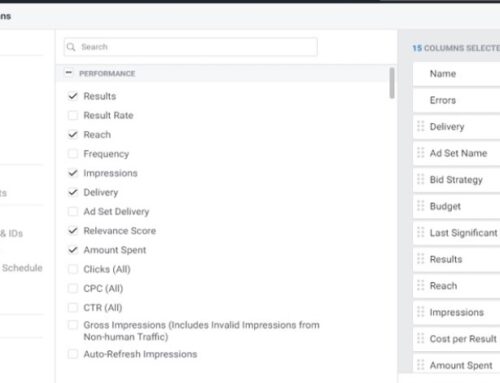Table of Contents
What are Google Ads keywords?
What are keywords in Google Ads? They are probably the most important thing in the field of paid search or Google’s search ads.
Paid searches are ads in text format. They mainly contain 3 headlines, 2 descriptions, a URL, and many ad extensions that go along with it. Keywords decide when these ads should show up in the search results. By selecting high-quality, relevant keywords for your ad campaign that helps you reach only the most interested people, you can convert them into customers as they are conducting their searches online.

Keywords are the bread and butter of paid search. Advertisers use keywords to select when to show an ad to a user. As a result, the user searching gets presented a relevant ad that meets what they are looking for; they click onto your website and hopefully convert into a sale or lead.
Be there when a user searches; convert them into a customer. That’s the goal of all paid search ads.
What are the different types of Google Ads keywords?
As of writing, they are 3 keyword match types in Google Ads. Broad, phrase, and exact match. Each of these match types behaves differently, the most significant difference being their matching ability. The broad match can match the most number of search queries, the phrase match sits somewhere in the middle, and exact has the strictest matching ability.

It is important to understand that the broader match type will capture all search queries of narrower match types and more. A broad match keyword will automatically match all phrases and exact versions of it. All phrase match capture their exact match counterparts. Because of this time-saving ability, we do not have to create exhaustive keyword lists of the same keywords in different match types like back in the day.

It is important to note that in the current Google Ads, all keywords match to close variants regardless of their match type.
Before we can take a deep dive into each of the 3 existing keyword match types, we need to understand close variants.
Close variants
The official definition by Google is that: “Close variants allow keywords to match to searches that are similar, but not identical to the targeted keyword, and help you connect with people who are looking for your business—despite slight variations in the way they search—reducing the need to build out exhaustive keyword lists to reach these customers. By default, all keyword match types are eligible to match to close variants. There is no way to opt out.”
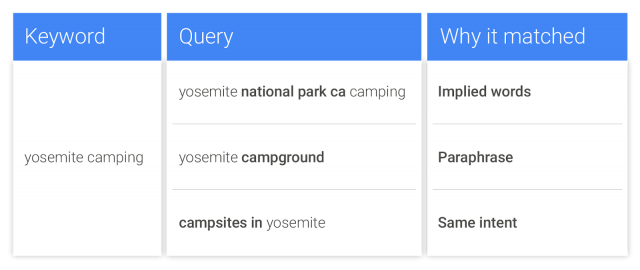
Google has created a long list of criteria as to what counts as a close variant match. Just remember this: your keyword can match as long as the meaning is similar. This includes misspellings, abbreviations, and plurals.
Broad match
Now, let’s take a look at the various match types, beginning with broad match. Broad match is the biggest catch of them all.
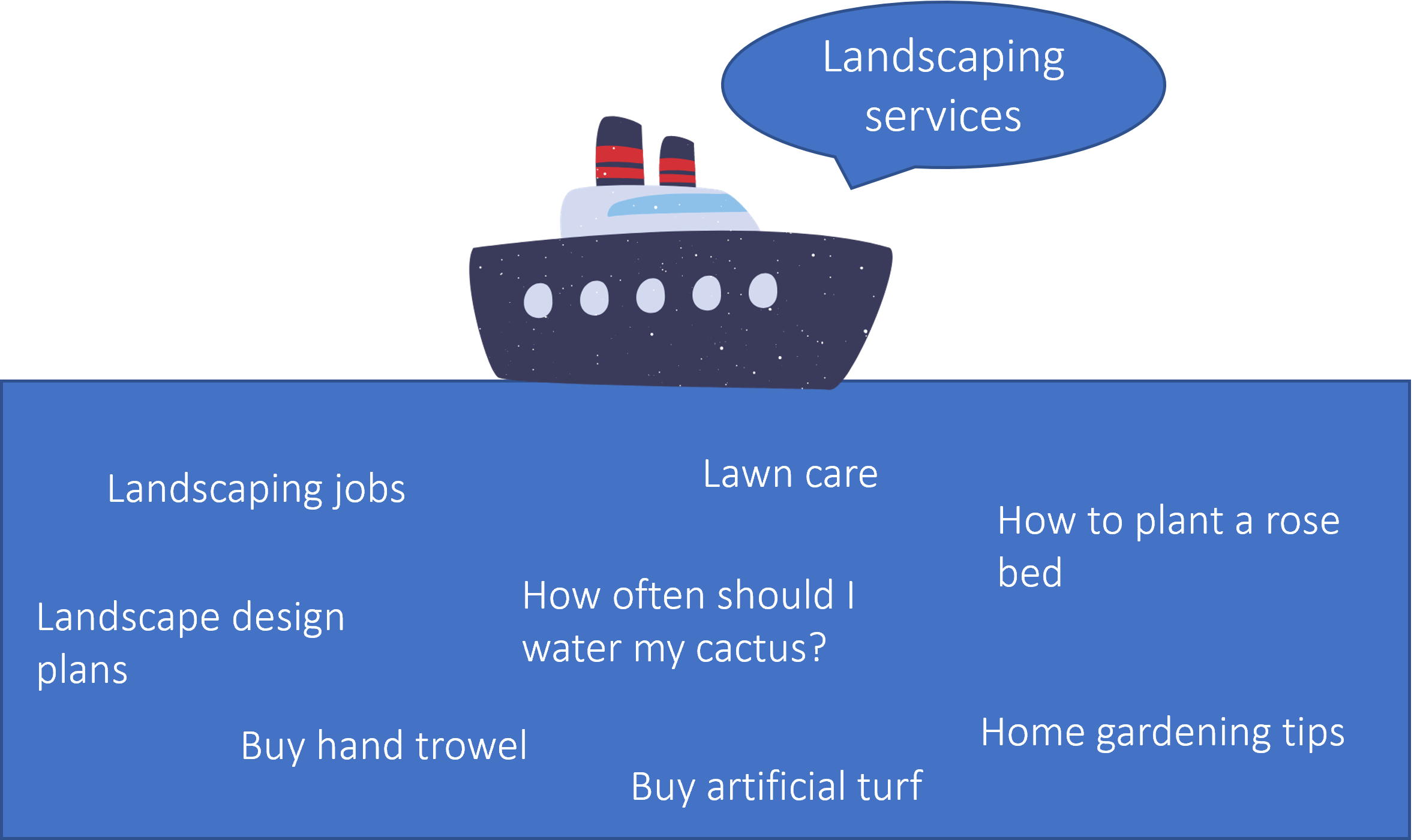
When you use broad match, you are casting the widest net possible in the ocean of traffic. You are telling Google to bring as much traffic to you as possible based on your broad keyword. As a result, you will receive traffic from relevant and also irrelevant searches that may be lying outside of your keyword peripheral.
Broad match has no designation; you simply type the keyword out.
In the image above, you can see that the broad match keyword, “landscaping services” matches with many types of queries, even those that are outside of its meaning. Broad match gives Google the greatest freedom to match your ads with searches. However, there are benefits and setbacks to using broad match. Let’s explore.
Broad match tip 1: Allows for additional keyword mining
Having you broad match keywords expands the data in your search terms reports. This allows you to mine valuable keywords you may have missed during the initial keyword research. In addition, since your customers are essentially triggering the ads, you can see how different they are searching than what you may have expected.
Broad match tip 2: Becareful of ad wastage
Ad wastage or budget waste is when your ads run to a user who will likely not become your customer. These traffic may still click on your ads, but they are as good as wasted money. This is the main reason why so many advertisers avoid broad match keywords in their accounts.
Broad match tip 3: Use broad match with smart bidding
Ad wastage is still prevalent, but way less than many years ago. With the rise of machine learning optimizations, Google now recommends using broad matches along with smart bidding.
The point of smart bidding is to leverage Google’s machine learning capabilities to bring you results at your desired goal, be it impression share, click volume, or the more commonly, Cost Per Acquisition (CPA) and Return on Ad Spend (ROAS).
Many advertisers complain about giving Google the ‘full reins’ by letting them match to whatever keyword they please; they think they can make better decisions than machines. But the opposite is true. As long as you have set your conversion tracking correctly and attributed the correct value to these actions, Google’s machine learning will try to work in order to reach your targets.
Give smart bidding a proper goal
When you give smart bidding a task, like a $20 CPA or 400% ROAS, you are telling it to use your money and to return with these target results.
That being said, machine learning does not think like a human. It doesn’t have emotions or biases. Instead, it is programmed to try its best to bring you the results you set it to achieve.
When you pair up broad match keywords with smart bidding, Google machines have to learn and figure out the best way to work with these keywords to bring you the return you ask for. It may not always succeed, especially if you set an unattainable goal, say 2000% ROAS, when your industry averages 400%.
All the machine is going to do is become so conservative that it will not dare to enter into any auction, and as a result, you will likely end up with no ads running. The key is to bring the right balance.
Phrase match
Phrase match allows you to trigger search queries that include the meaning of your keyword. The meaning of the keyword can be implied, and user searches can be a more specific form of the meaning. Phrase match is more flexible than an exact match but is stricter than a broad match. With phrase match, you allow for searches broader than your keyword, as long as your phrase match meaning is still within the search query.

Unlike in the past, the order of your keyword no longer matters now. The main focus is now on meaning and semantics. Google matches you with search queries with the same meaning as your phrase keyword.
Phrase match is designated with parenthesis, such as “red shoe”.

The above is the official documentation from Google. In this case, the phrase match keyword “tennis shoes” cannot trigger search queries like:
1. Tennis rackets and training shoes
2. Can you wear running shoes for tennis
Because Google believes the meaning is different now. Running shoes, training shoes, and tennis shoes should be treated differently.
If you were using broad match “tennis shoes” instead, the 2 queries above would be eligible to trigger your ad.
Phrase match tip: Start with it
Phrase matches are an ideal choice for most advertisers to start with. Even though smart bidding and Google still strongly suggest using broad match, gradually easing into broad match may be a good solution. Unless you have a humungous budget, starting a fresh account solely on broad match will blow up a lot of money before machine learning can settle into gear.
Exact match
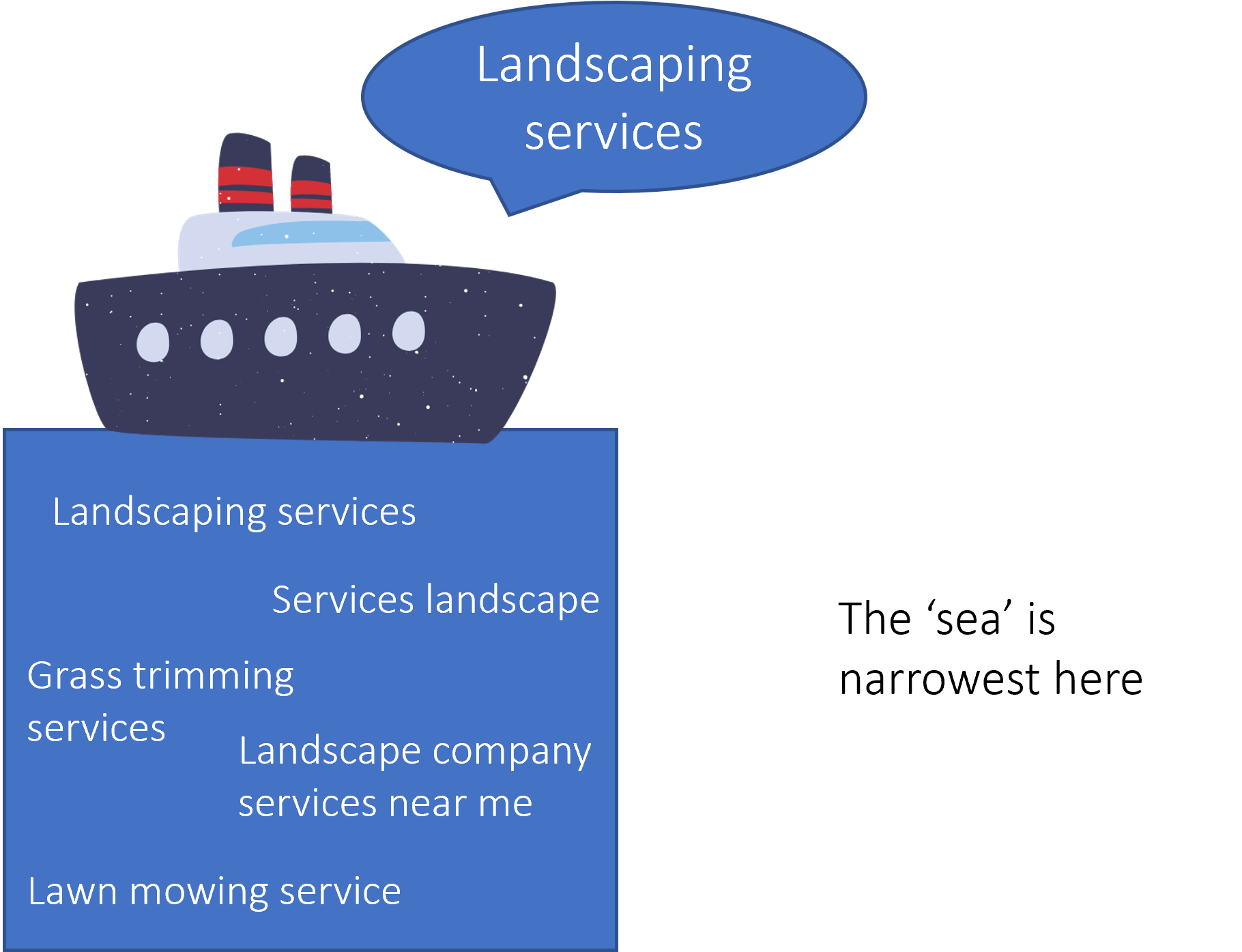
Exact match is Google’s strictest keyword match type. If you wanted full control while only matching to the meaning of your keyword, use exact match. It is built for that purpose. Ads may show on searches with the same meaning or intent as the keyword. Of the three keyword matching options, exact match gives you the most control over who sees your ad.
Exact match is designated with brackets, such as [red shoe].

The example above is from Google. An exact match keyword of [shoes for men] will trigger searches when the meaning is intact. But it will not trigger if the meaning is different.
In this scenario, ‘tennis shoes’ and ‘shoes for boys’ will not trigger the keyword [shoes for men]. This is because, in the first case, the user is searching for tennis shoes. In the second case, the user searches for boy’s shoes, indicating that the wearer is probably a child.
It is important to understand the distinctive factors that separate exact matches from one another. It starts from the broadest to the narrowest.
Broad match modifier (deprecated)
Broad Match Modifier (BMM) deserves a special mention. It was sunset by Google back in June 2021. Google has announced that phrase match will take its place and match into more relevant queries. Advertisers used to be able to use the designation “+” to indicate a broad match modifier. It sat in the middle of broad and phrase match in terms of matching ability.
Google states that the reasoning for this is that both phrase match and broad match modified keywords “often serve the same use cases, and that you can reach more of the right customers through a combination of the two.”
The second reason was likely towards easier management. Google continually tries to make its API simpler and more friendly to use.
If it is simpler, more people will be inclined to start advertising with Google. The learning curve for a newcomer to using Google Ads efficiently is so much higher than on any other ad platform. Deleting BMM keywords helps make the interface more user-friendly. This is a move welcomed by most non-professionals and even professionals.
Negative keywords
Let’s move on to negative keywords.

Negative keywords are the opposite of your usual keywords. In this sense, you are telling Google what not to show your ad on. There are lots of searches that happen in Google every day, most of them you just don’t want to show up for. If you did, you will probably be wasting a lot of money. Searches that may be triggered by your ads that are just plain irrelevant will need to be excluded.
Negative broad match

Negative broad match covers the biggest exclusion range when it comes to exclusions. It is the default match type and has no designated sign, just typing out the keyword will treat it as a negative broad. For negative broad match keywords, your ad will not show if the search contains all your negative keyword terms, even if the terms are in a different order. However, your ad may still show if the search contains only some of your keyword terms.
Negative phrase match

For negative phrase match keywords, your ad won’t show if the search contains the exact keyword terms in the same order. The search may include additional words, but the ad won’t show as long as all the keyword terms are included in the search query and in the same order.
The example above from Google, whenever the phrase ‘running shoes’ appears anywhere and in any order within the search term, it is automatically excluded. The difference between negative phrase and broad is that phrase emphasizes on the words appearing in the exact order, while broad is excluded as long as all the keywords are in the search query.
Negative exact match
Finally: negative exact match. It has the weakest exclusion range out type all. I will tell you that I have almost never used this match type. It is just not that useful. Let’s see why.
For negative exact match keywords, your ad won’t show if the search contains the exact keyword terms, in the same order, without any extra words. Just think of a CTRL-C and CTRL-V (copy and paste). Your ad won’t show if the searcher typed in the exact same words as the one sitting in your ad account.
Your ad may still show if the search contains the keyword terms with additional words.
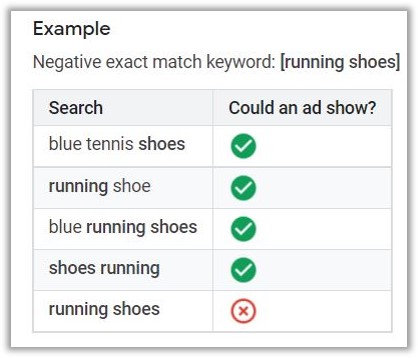
An example above from Google, whenever the exact match [running shoes] appear exactly as the search term, it will not serve your ad. Note that the search term has to be exactly as written in your keyword, 1:1.
Still, let’s examine and see on the rare occasion you should employ negative exact match keywords in your account.
- You only want to exclude that exact search term and nothing else.
This could apply to specific brands with which you don’t want any association. For example, say your business is competing with your competitor named “SunnyBanana”. Both of you are competing on “fresh fruits” keywords, so you want to show when someone searches for “SunnyBanana fresh fruits”. But SunnyBanana also sells a bunch of other products that you don’t sell. So by using the negative exclusion [SunnyBanana], it will exclude you from brand searches with less intent while still keeping you open for searches like “SunnyBanana fruits”.
As for now, you will find that most search terms can be covered by both negative broad and negative phrase matches. Negative exact is being used for hyper-specific situations like the one just stated.
Benefits of negative keywords
Negative keywords are a prime essential within every ad account. No successful paid search campaign can run without comprehensive and consistently updated negative keyword lists. Direct benefits of using negative keywords increase your ad’s CTR since fewer impressions are being wasted. A higher CTR usually results in a cheaper cost per click, so you not only waste less money, but you also spend less money.
High CTR and ad relevancy give you a higher keyword quality score, thereby increasing your Ad Rank in the auctions, which means more chances of being in the top position of search results.
Keep in mind when dealing with negative keywords
Negative keywords may come with many benefits, but it’s important to keep a few things in mind when dealing with them.
Negative broad match

Most of the time, you should look to add negative broad matches. This is because negative broad matches give the most coverage and exclusions. Most of the time, when you add negative keywords, you do not want to show for that keyword, period. This premise alone is good enough to select the broad exclusion.
However, you may find that phrase and exact is the proper fit on some occasions. For example, you may still want to show for a keyword, but not when it’s phrased in a particular way.
For example, to prevent 1-word searches from triggering your ads, say “marketing”, but you still want to rank for “search engine marketing”, in this case, you should add the word as a negative exact match, like [marketing]. Since you may find that people who search for just “marketing” is too broad and mostly shows no intention to convert.
Close variants do not apply

Unlike normal keywords, negative keywords do not match to close variants, so your ad is still eligible to show on searches containing close variations of your negative keywords. Remember to add multiple variants of the keywords you exclude! If you don’t, you will find that you will still get matched to searches that you have already blocked, just that it is now in a plural, misspelled, or abbreviated form.
Unintentionally blocked out of searches
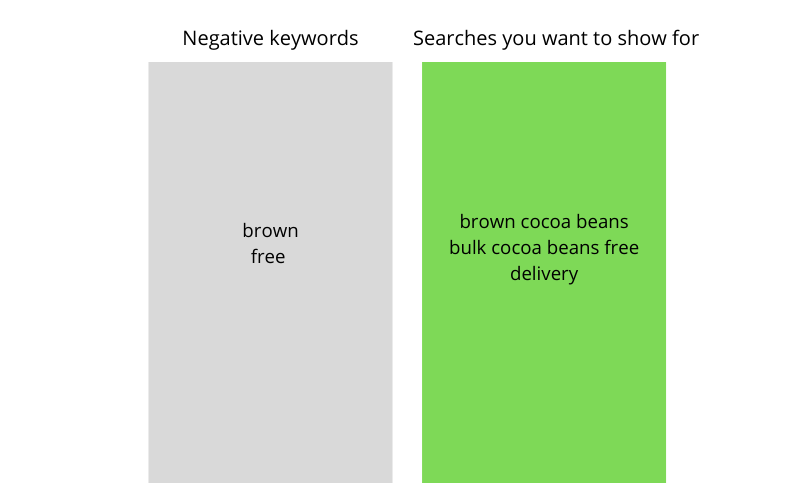
“To live is to err” is a common saying. When applying negative keywords to your account, you may unintentionally block out relevant searches in your campaign that you still want to show for. For example, if you are bidding a keyword “cocoa beans” and you exclude the word “brown” in your negative keywords, you will have accidentally blocked out searches for “brown cocoa beans” which you also intend to sell.
So be careful of what you exclude as a negative keyword. If you employ it carelessly, they may overlap with your positive keywords and cause them to be ineligible to show.
Use a list
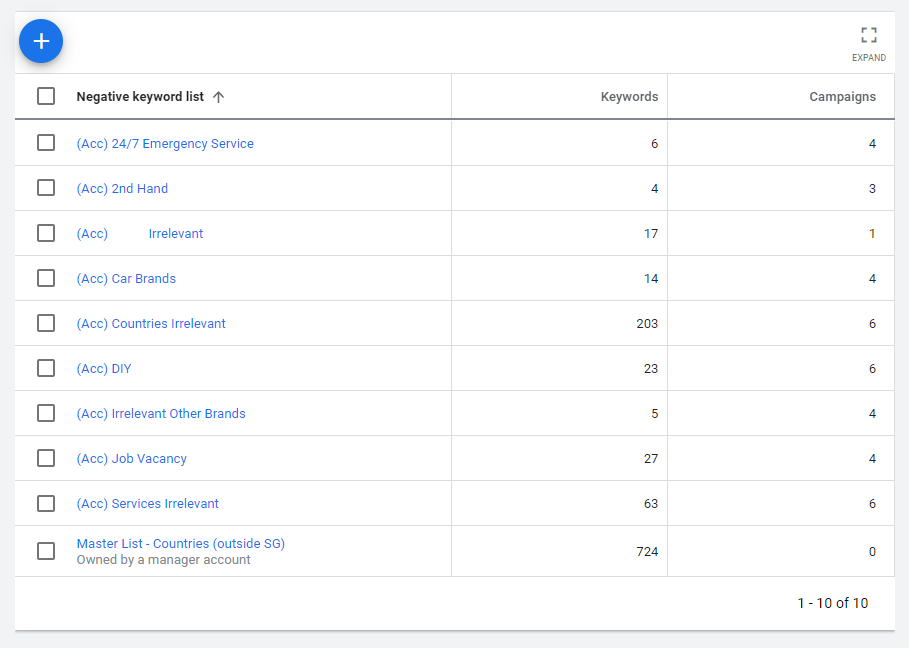
Use negative keyword lists and maintain a hierarchical order with them, even as accounts grow. The number 1 mistake advertisers make is adding negative keywords directly into the campaign, like their positive counterparts. While this is not wrong, it is highly inefficient and unmanageable.
Building out negative keyword lists and adding negative keywords directly into the lists is the best way to maintain clear management in your account in the long term. Easier management means better optimizations and more profits.
When choosing keywords, look out for these qualities
Now that we have an understanding of the different match types and negative keywords, let’s discuss a few important criteria when selecting keywords for your business. If you keep these criteria in mind when doing your keyword research next time, you will definitely end up with a successful keyword strategy for your account.
Search volume

Google keyword planner (which we will get into shortly) and a host of other keyword tools usually come with the search volume of the keywords. This shows how many times a keyword has been searched every month. Click here if you want to learn advanced tips when using Google keyword planner.
This metric lets you evaluate how popular a specific query is and how much potential traffic you could direct to your site if you successfully rank for them. Typically the larger the search volume, the more competitive it is, as more users will want to rank for this keyword on page 1. Long-tail keywords will be easier to rank as they typically have lower search volume.
Keyword competition

No matter how impressive the search volume of a keyword is, you should be mindful of the level of competition. The higher the level of competition, the harder it is to win a spot on page 1. For example, an accounting company bidding for “accounting” is going to be faced with a lot of competition.
Most keyword tools will come with a “competition” metric, so take it into consideration when choosing your keywords.
Price

Within Google Ads, every keyword has a price known as “cost per click” (CPC), this tells you an estimate of how much you can expect to pay when someone clicks on your ad after triggering your keyword.
When you are planning an advertising campaign, evaluating the CPCs of your target keywords is necessary for managing your advertising budget and estimating the cost of a campaign. Yes, you may find a keyword that you absolutely want to rank for, it is high-intent and transactional, but if the CPC is $20 and your account CPC is usually only around $2-3, then it may be time to consider if you should bid for this keyword or use another word.
The CPCs of your target keywords will influence your overall advertising budget.
Word count

Some keyword tools allow you to filter the word count of a keyword. Usually, the word count of a keyword tells you whether it has context or intent. Long-tail keywords are usually high-intent keywords. Someone searching for “Best aircon cleaning near me” is closer to the transaction than a generic search for “Aircon”. The first is 5 words long, the second is only 1 word.
Longer keywords tend to be easier to rank your ads as they usually have lower competition.
The example above is from the SEMrush keyword tool.
Keyword intent
The intent of the keyword lets you know what the searcher is looking to do. Search queries have traditionally been separated into 3 main kinds.
Informational

Queries that are looking for information such as directions, facts, knowledge, etc. without an explicit intention to make a transaction related to this search.
Navigational

Queries that show an intent to navigate to a specific website or content.
Transactional

Queries that represent a strong intention to make a transaction on a website.
The main purpose of Google Ads is to target the last category of search queries. Those that have transactional in nature, that’s what we want to spend money on.
How to choose the right keywords
When selecting keywords, you should always try to triangulate your sources. This means that don’t just rely on 1 source for your keyword research, instead use a few to have a broad coverage of your market searches. You will also avoid potentially missing out on any keywords that may be valuable to your business. Below are some ways you can perform keyword research for your business.
Google Keyword Planner

Google’s own Keyword Planner is a powerful tool (and probably the best choice) to help you research and find the most targeted keywords to use. Its data comes directly from Google’s own servers, thereby making it very reliable. Data includes average monthly searches in the past 12 months, keyword competition level, the average cost per click. You can even refine keywords results based on their theme.
One key benefit is that since it is native to Google Ads, advertisers can add the keywords directly into a plan or campaign and have it working right away.
SEMrush
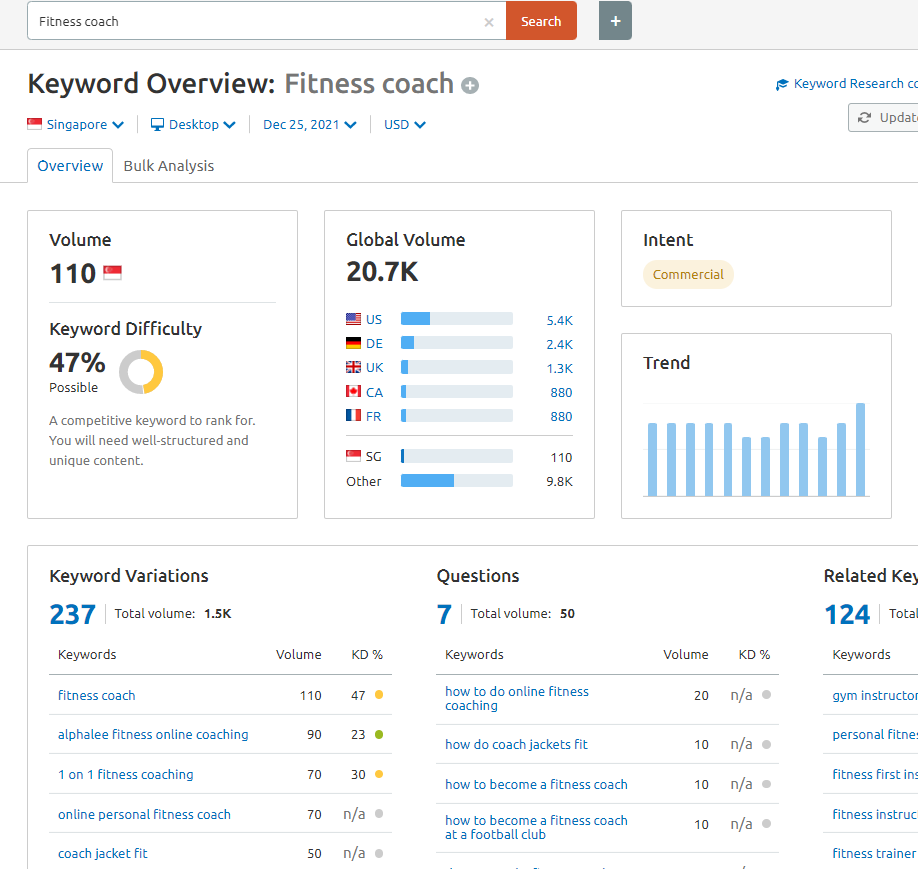
SEMrush is one of the most popular keyword research tools in the market. The only drawback is that it is a paid option. Within the software gives you the ability to do extensive keyword research, see the keyword gap between you and your competitors, what users are searching on Google, and the search volume.
SEMrush offers something unique that is not available within Google keyword planner. It shows you your competitors’ data and sees what type of keywords and ads they are using.
Brainstorm it

One easy way is to take out a piece of paper or notepad on your desktop and literally start brainstorming. Nobody knows about the business more than yourself. Gather your employees and team members and begin brainstorming the multitude of ways someone can be searching for your business. Running a paid search campaign involves considerable costs to the company, so get your company committed to making it work.
Google autocomplete
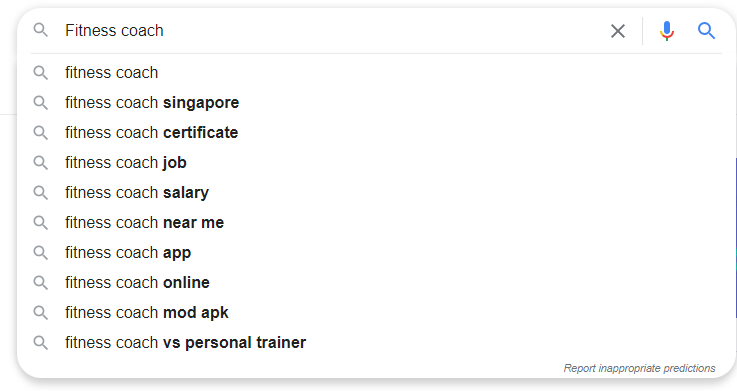
Google autocomplete appears whenever you search a term on Google. Type in anything and you will find Google suggesting other related terms. It always shows 10 suggestions under your search query. Scroll down into any SERP page and you will also see ‘related searches’ at the bottom. This is Google’s internal data, based on what searchers alike tend to search.
Autocomplete predictions reflect real searches that have been done on Google. Google’s systems look for common queries that match what someone starts to enter into the search box to determine what predictions to show. This alone gives you a powerful way to understand how your customers are searching for you, just by typing your own keywords in the search bar.
Search terms report
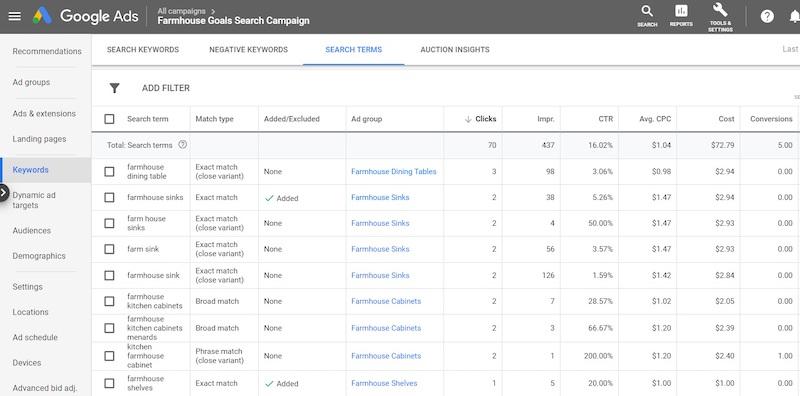
The search terms report within your Google Ads provides insight into the searches that have triggered your ads. In addition, search terms report is very powerful for finding missed opportunities for keywords and negative keywords to exclude. Set a date – preferably once a week, to scan your search terms reports to look for keywords that you may have missed.
Use Dynamic Search Ads

This is not exactly a keyword research strategy but it’s worth mentioning. Dynamic Search Ads helps you gain additional traffic and sales by identifying new serving opportunities that you aren’t already targeting with keywords. It works by having Google bots crawl your landing pages and understanding what it can mean, then sends user searches based on your landing page content. You do not bid keywords on this since Google will automatically try to match you with related search terms.
Dynamic Search Ads were initially designed for large retailers. Since they had thousands of product pages on their website, it is just impractical to do keyword research for every product and page. Imagine how long this would take. So Dynamic Search Ads was created, and Google bots crawled those large retailer sites and created ads on their behalf; one good example is Amazon. The pros are usually are very targeted ads to the searcher and can have high click-through rates.
The good thing is that even normal websites can take advantage of it. Dynamic Search Ads use your website content to target your ads and can help fill in the gaps of your keyword-based campaigns.
Group similar keywords into ad groups
Now that you have completed your keyword research, it is time to put them into relevant ad groups. You don’t want to have keywords that are not related within the same ad group as this will cause irrelevant ads to show to users. Google will then penalize you with a low-quality score. Here are some tips when grouping keywords.
Tip 1: Use different match types but don’t repeat the keyword
Within an ad group, use different match types if necessary. You are not confined to a single match type. Use whatever makes the most sense for your business. For example, if you are looking for wide coverage and don’t mind a few ‘outside the box’ queries, go for broad match. If you want to tighten up your searches, use phrase match. Exact matches are perfect for brand keywords and will usually net you a high-quality score.
Remember not to repeat the same keyword with a different match type as it will not give you any additional benefit.
Tip 2: Align keywords to customers search behavior
This point is self-explanatory but still important. The whole purpose of mining and selecting keywords for your campaigns is to be there when your customers are searching. Find the perfect balance between search volume and search intent. If you are targeting keywords like “Chocolate” or “Delicious Chocolate Chips Soft and Chewy”, you will end up with no results.
The first keyword is too broad and will match you with so many irrelevant queries that you will just blow up your budget with nothing to show for. The latter ensures nobody ever sees your ad since it will hardly match to any query.
Tip 3: Think like your customer
Keywords aside, don’t forget the ultimate motive of running search ads: Being there when a customer searches and getting a sale or lead. Think like your customer! Put yourself in their shoes; what kind of ad most appeals to them? If it’s appropriate, you can even ask them directly. If not, watch how they are behaving during the sales process. What questions are they asking? What concerns do they have? Which information helps them make the final decision? Is it the price, the features, or the convenience? Knowing these will help you select your keywords and write your ad copy.
Knowing exactly what your customer thinks keeps you in touch with their needs and creates a pleasant experience for them.
Summary
There you have it. By now, you should have a very thorough understanding of how keywords work within Google Ads. If you also use Microsoft search, the rules mostly apply over as well.
We have covered what keywords are, the different keyword match types, close variants, negative keywords, a few warnings when using negative keywords, the best ways to perform keyword research, and important things to note when grouping your keywords. Now with this actionable guide, go conquer your keyword strategy in Google Ads!


